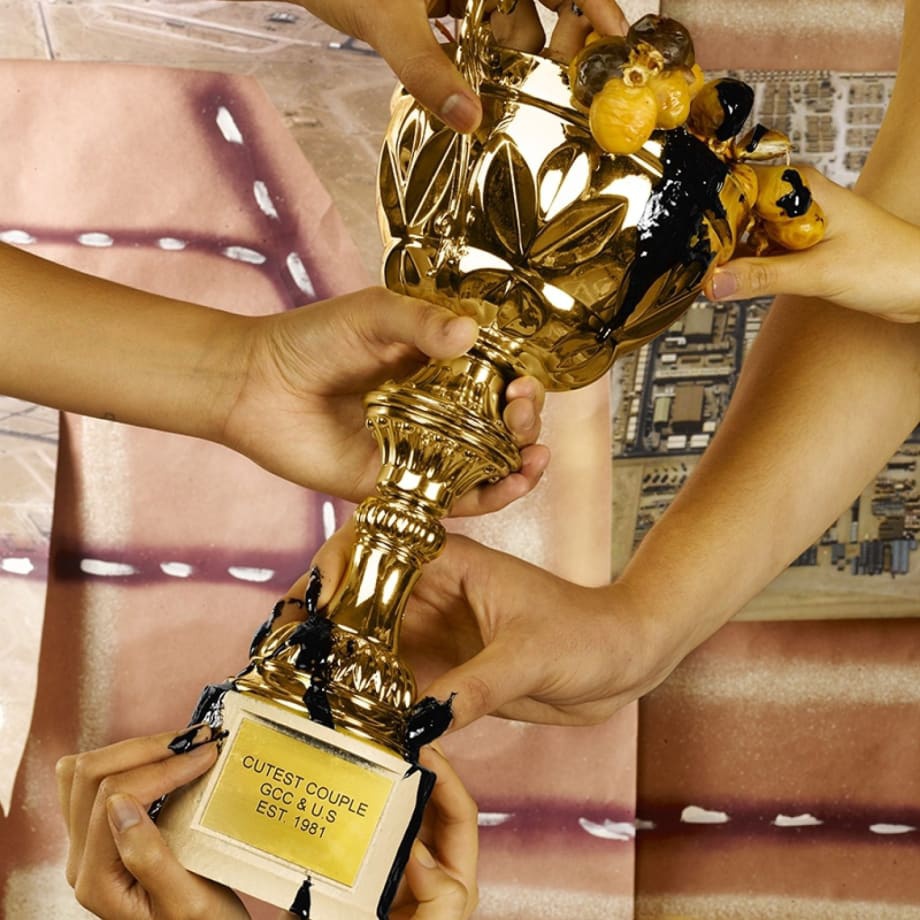30 March 2021 Sheida Soleimani is an Iranian-American artist who makes artwork at the intersection of installation, sculpture, and photography, which deals with themes of power, materiality, and violence in the context of American conflict in the Middle East. Soleimani speaks with Silver Eye Scholar and Point Park University Senior Camryn Drabenstadt her about her new work, Levers of Power, which was shown in a solo-exhibition at Denny Dimin Gallery in New York City in November and December of 2020.

Sheida Soleimani, GCC Trophy, 2018
Camryn Drabenstadt: How has the trauma your parents experienced moving from Iran to the United States shaped your practice?
Sheida Soleimani: I make photographs for a world in crisis. Viscerally and intellectually formed by my dissident father’s persecution and my mother’s torture during the 1979 Iranian Revolution, I strongly believe that crises demand new aesthetic forms, alternative genres, and heightened theatricality—in modes like humor and the grotesque—to get our messages across. Accordingly, even as I confront traumatic events in my practice, ranging from executions and torture to the slow deaths of citizens at the hands of their governments, I eschew traditional ways of photographing pain in favor of other methods, which I believe to be more ethical and more effective.
In what ways does Levers of Power differ from your other work dealing with oil, political power, and conflicts in the Middle East?
Levers of Power is just another angle of the issues that I tackle throughout my various series. Medium of Exchange focuses on the corrupt relationships of OPEC oil ministers and western government officials, while Levers situates politicians’ gestures in situ to the citizens they govern and harm. Each image has sprung out of an event that has happened within the past year between Iran and the United States.
Could you talk me through your ideas surrounding oil as a substance, especially in the still lives in CRUDES?
While researching the oil industry and trade for my series Medium of Exchange, I came across a page filled with the names of various crude oil blends, and found them to be really funny. Names that suggest flavors or characteristics-- the way we think of weed strains or tasting notes in wines made me think of creating still lives that explored the dark side of the crude oil industry, while using their names to create bright and poppy food advertising types of images. The series, titled CRUDES, investigates a niche sector of the oil industry by creating portraits of various crude oil blends, while researching their often humorous names as well as their histories and origins. Each portrait is composed of a satellite image of where the crude oil blend is produced. Alongside this are various manufactured goods, often referencing sporting prowess, power and musicality, characteristics commonly associated with the oil industry, that are derived from each crude. Lastly there is the primary agricultural or food trade that has been impacted by the refinery's presence.
Hands, arms, and faces are symbols that pop up throughout your projects, do you have any specific thoughts on repetition of symbols in your work?
Humor and the grotesque are both very important in my works. Exaggerating figures can make them look comical, but also say something about the types of relationships in which they are involved. Levers of Power isolates the gestures of politicians to initiate viewers to question the role of body language in popular media images. If monuments crystallize and classicize gestures of power (and can be read as gestural themselves), photographs of world leaders capture a different register of political gesture.
In what ways has the history of collage influenced your work? Can you tell me about how you use the act of cutting and violence as elements of collage in your work?
Hannah Höch created Frankenstein-esque cyborgs through cutting, splicing, and re-situating images; resulting in distorted and grotesque figures that reflected a time of societal upheaval in Weimar Germany. Cutting is a violent act, and when I cut and re-situate images I think about the traumas that are already taking place within the photographs themselves as well as how I can reconstruct existing images to create new narratives. In focusing on media trends and the trajectories of societal and political events, I often source images from popular media, as well as social media leaks, re-situating them within alternative scenarios, in order to open spectators up to new critical horizons.
Could you tell me a little bit about how you construct your sets? What does that process look like for you?
By building theatrical sets, ranging in size from the wall of an entire building to a small tabletop, I combine diverse assemblages of culturally overdetermined objects, in a practice similar to what Marx called bricolage, to make a thing called a “photograph.”
I first print images sourced from the web: often these are of torture victims, prisoners, executioners, and dictators, amongst a multitude of politically situated images. I cut these printed images and collage them with three dimensional objects that reference research pertaining to each specific scene and tableau. After creating a 3-d set, assembling bodies, props, and symbols, I photograph the tableau as a still life, flattening the layers of the physical forms to reassert the aggressive nature of the sourced images, blurring the boundaries of what some believe to be ‘digitally created’ vs what can be manipulated in physical space.
Has the pandemic changed how you think about this work?
Human rights violations have not stopped for the pandemic: these issues are rampant, and citizens continue to suffer at the hands of corrupt regimes. The pandemic has certainly exacerbated many citizens' access to basic human needs, but my work continues to consider how governments often fail to provide for their peoples.

